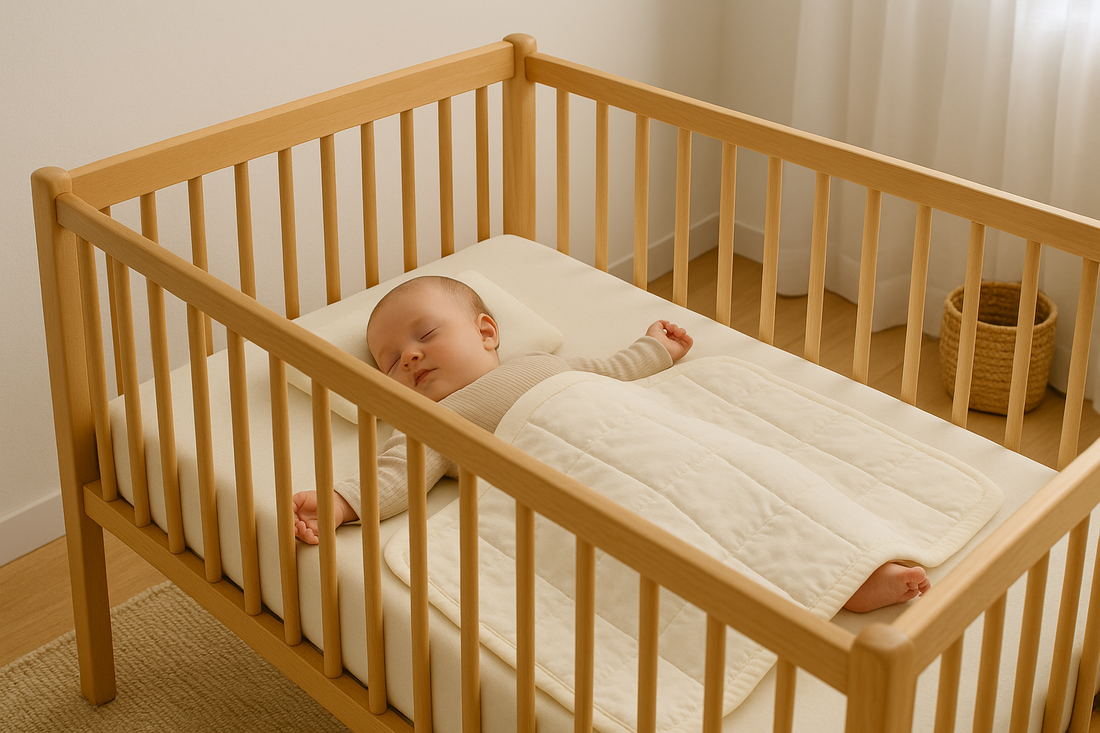The Hidden Risks of Overheating: How to Dress and Layer Your Baby for Sleep

When it comes to your baby’s sleep, most parents focus on keeping them warm and comfortable. But did you know that overheating is one of the leading risk factors for Sudden Infant Death Syndrome (SIDS)? Striking the right balance between warmth and safety is essential for your little one’s well-being.
In this guide, we’ll explore the hidden dangers of overheating, how to recognize the signs, and practical tips on dressing and layering your baby for a safe and restful night.
Why Overheating is Dangerous for Babies
Babies are more sensitive to temperature changes than adults because they can’t regulate their body temperature effectively. While being too cold may make your baby fussy, being too warm can lead to serious health risks.
Here’s why overheating is a concern:
-
Increased SIDS Risk:
Research shows a strong link between overheating and Sudden Infant Death Syndrome, especially during the first 6 months of life. -
Heat Stress:
Excessive warmth can cause dehydration, restlessness, and disrupted sleep patterns. -
Breathing Difficulties:
Overheating may impair a baby’s breathing or cause them to enter deeper sleep, making it harder to wake up if there’s an issue.
Pro Tip: A safe sleep environment should always be cool, comfortable, and breathable, rather than overly warm.

How to Tell if Your Baby is Overheating
Parents often worry about whether their baby is warm enough. Here’s how you can tell if your baby is too hot:
- Sweaty Neck or Damp Hair – The back of the neck is a good spot to check.
- Flushed Cheeks – A sign that your baby’s body is overheating.
- Rapid Breathing or Panting – This may indicate discomfort or heat stress.
- Restlessness or Fussiness – Babies often wake up or cry if they feel too warm.
If you notice these signs, remove a layer of clothing or adjust the room temperature.
Ideal Room Temperature for Baby Sleep
The ideal nursery temperature for sleep is 68–72°F (20–22°C).
Here are a few tips to help maintain this range:
- Use a room thermometer to track the temperature accurately.
- Keep the crib away from direct sunlight, heaters, or drafts.
- Opt for lightweight bedding and breathable fabrics.
How to Dress Your Baby for Sleep
When dressing your baby for sleep, remember this simple rule:
Dress your baby in one more layer than you would wear comfortably in the same environment.
Here’s a seasonal guide:
Warm Weather (Spring/Summer):
- Short-sleeved cotton onesie
- Lightweight sleep sack or swaddle
- Avoid heavy blankets or fleece
Cool Weather (Fall/Winter):
- Long-sleeved cotton pajamas
- Medium-weight sleep sack or wearable blanket
- Add a light onesie underneath if needed
Important: Avoid hats, mittens, or any loose accessories in the crib, as they increase the risk of suffocation.
Safe Layering Tips for Your Baby’s Sleep
Layering correctly is key to keeping your baby comfortable without overheating.
-
Start with a Breathable Base Layer
-
100% cotton onesies are ideal as they allow airflow.
-
-
Use Wearable Blankets Instead of Loose Covers
-
Sleep sacks are safer than blankets and prevent entanglement.
-
-
Avoid Over-Bundling
-
One fitted sheet and a sleep sack are usually enough.
-
-
Check Temperature During the Night
-
Place your hand on your baby’s chest or back. It should feel warm, not sweaty or clammy.
-

Overheating and Bedding Choices
The type of bedding you choose plays a big role in preventing overheating.
Here are safe and breathable options:
-
Fitted Crib Sheets:
Made from 100% cotton to promote airflow. -
Organic Cotton Sleep Sacks:
Soft and gentle on sensitive skin. -
Firm Crib Mattress:
Provides support without trapping heat.
🌱 Shop breathable and safe baby bedding: Brandream Baby Bedding Collection
When to Adjust for Growth and Development
As your baby grows, their sleep needs will change.
Here’s a quick age guide:
-
Newborns (0-3 months):
Stick to a swaddle or sleep sack with a single cotton onesie. -
Infants (3-12 months):
Transition to wearable blankets and light layering. -
Toddlers (12+ months):
Consider introducing a small, toddler-safe pillow and lightweight quilt once your child moves to a toddler bed.
FAQs About Baby Sleep and Overheating
Q: Can my baby sleep with a blanket in winter?
A: No. Instead, use a wearable blanket or sleep sack to keep your baby warm without the risks of loose bedding.
Q: How do I know if my baby is too cold?
A: Check their hands and feet—they may feel cool, but the chest should feel warm to the touch.
Q: Should I use a space heater in the nursery?
A: Only if absolutely necessary, and ensure it’s placed far away from the crib and monitored for safety.
Conclusion
Overheating is a silent risk that every parent should be aware of. By keeping your baby’s room at a safe temperature, dressing them appropriately, and choosing breathable bedding, you can create a safe and cozy sleep environment.
Remember:
Your baby doesn’t need to be bundled like an adult. A cool, comfortable setting is the best way to ensure safe and restful sleep.
Shop Safe Bedding
Discover our curated selection of organic, breathable baby bedding designed with safety and comfort in mind.
Explore Brandream Baby Bedding Collection
